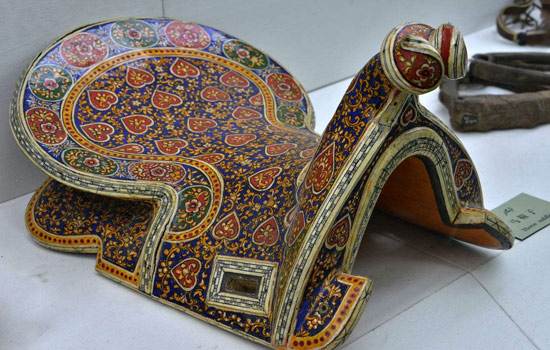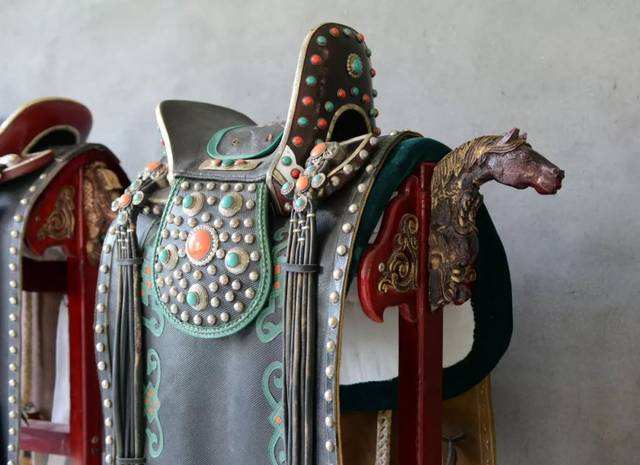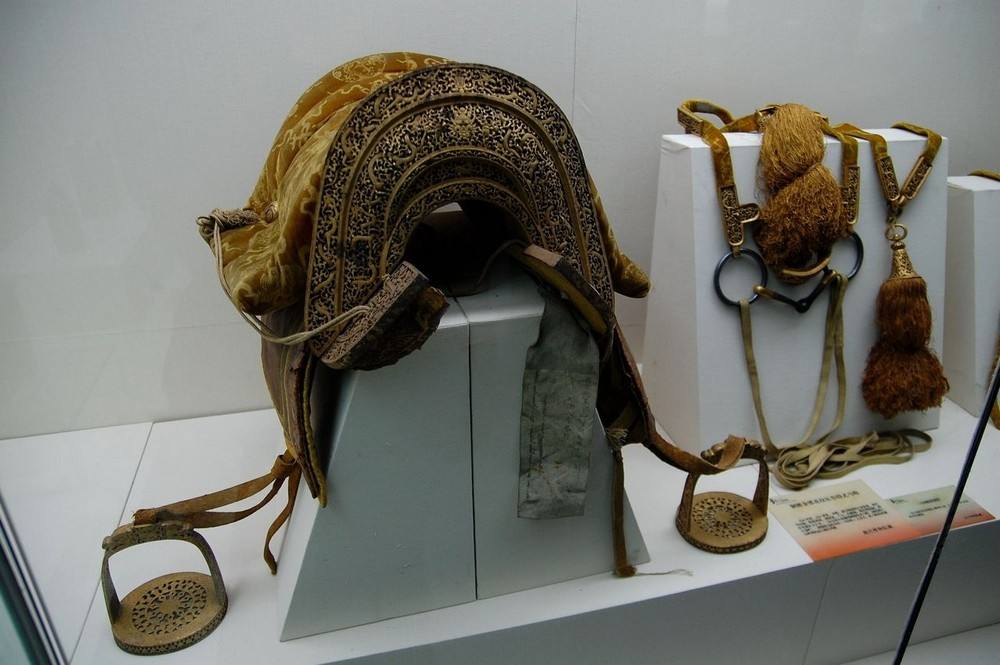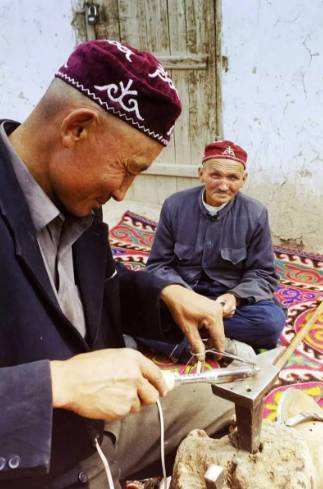The Heroic Ideal of Galloping on the Grassland
6 min readMaking a saddle
Saddle making is generally a technique of the nomadic ethnic groups, for instance, the well-known exquisite handicraft of the Kazakhs, the Mongolians and the Khaklhas. This kind of handicraft is rare among the Uygurs who are mostly engaged in farming. So I was very delighted when I went to the house of Abliz Bay and saw the saddles piled in the courtyard. had always believed that riding a horse with a saddle was really heroic and romantic for a nomadic life.

The pommel horn of the saddle falls basically into two shapes. One is an oval bent with thick concrete iron, and the other is the shape of a Chinese character “”or an oval carved with good birch or elm wood. The -shaped pommel horn is usually wrapped with leather and the oval-shaped one is usually embedded with silver or gemstones. The cantle is in the shape of semi-circle, bending outwards embedded with jades or wrapped with leather.
The leather can be knurled, embedded with cooper and silver. The embedding technique is strongly stressed for wooden saddles which are usually embedded with gold, silk and various kinds of gemstones. Designs basically include the abstract image of sceneries on grassland which are very exquisite The saddle seat is usually covered with leather flap of mattress. A fine saddle equipped with a fine bridle will make the horse look spirited. In the past, it would equal to today’s BMW.

“A saddle is composed of a headstall, a girth and a pair of stirrups. The part under the saddle seat is made of metal and the surface of the saddle seat is embedded with yellow brass. The girth used to fasten the saddle needs to be made of cowhide to be endurable. To make a set of saddle, we need an adze, an axe, red bronze, brass, nails pliers, a hammer, clippers, copper rod, a cutting tool, poplar wood, deer skin, camel skin and cowhide. “Abliz Bay examined the finished saddle in his hand, with an imperceptible smile on his face. It is said that a craftsman needs to master the handicraft of a blacksmith and a carpenter to make a saddle. In the past, the iron was smelted by juniper tamarisk ember, and now it is smelted by coal ember. As for which one is better, Abliz Bay said he didn’t know. However, he believed the iron smelted by coal ember was fine and more durable.
An important mark of grassland civilization is the horse. We may well say that the horseback is the cradle of the nomadic ethnic groups. The nomadic people built their states, armies, and social order on the horseback and lived their life on the horseback. Attila and Genghis Khan, the two famous persons who had invaded Europe with their armies on horseback proved that horses brought wealth to the nomadic people, formed their characters, brought light and dream to them and formed their heroism and open attitudes.

The emergence of the saddle with stirrups was technologically an epoch-making event for Asia and Europe. In the eyes of scholars, the saddle and stirrup are the most important inventions among the entire harness, after curb bit and trace. The stirrup is called “Chinese shoe” by the western horse culture study community. Its invention marks a great development in human history and is of epoch-making significance to human civilization.
Wright, the historian of technology of the UK sang highly of the stirrup, “Few inventions have been so simple as the stirrup, but few have had so catalytic an influence on history.
The stirrup made it possible to join man and steed into fighting organism.” The constant improvement of the stirrup made it possible for the nomadic ethnic groups to create the horseback culture, free their hands and body and make it easy to get on and off the horses.
Owning to the stirrup, the horse rider can move freely on the horseback, for instance, pulling a bow, turning to shoot the arrow or changing sides while riding etc. The stirrup is the beginning of life for the herdsmen Its invention made it possible for nomadic men to extend their space of activity, and for women, the old and the young to be able to shoot an arrow while riding a horse. It emancipated and developed the social productive forces and also expanded the scope of activities of the nomadic people, broke the strict boundaries of gender and age in the nomadic social division of labor and collaboration. It made nomadic and rotational grazing without men possible.

In the era without the stirrup and saddle people needed to ride on the bare horseback, and keep them from falling off when the horse was galloping only by holding tight the trace or horse mane and clamping tightly the horse belly. The saddle provides longitudinal stability. The stirrups provide vertical stability by fastening the feet, and at the same time unite the rider and the horse into whole, which made it possible for the cavalrymen to charge front at the speed of the horse. Western scholars had a remark on the new equipment brought by the Huns who invaded Europe: “The saddle is the key to combine the man and the horse. The unique saddle of the Huns aroused the curiosity of the Romans.
Their saddles were different from the saddles of the Romans which were made of leather wrapped around the horse belly. Saddles of the Huns had a wooden bracket of two-head high, which made it possible for the cavalrymen to sit firmly on the horseback no matter how fast the horse galloped… In contrast the clumsy horsemanship of the Romans often caused the riders to lose their balance and fall off the horse. This was usually very dangerous and sometimes fatal… Besides the saddle, the Huns also brought a revolutionary innovation from Asia: the stirrups which the Europeans had never seen. In order to prevent leg fatigue after long-distance riding, they tied a bandage, a belt, or a leg strap woven with flax to the saddle. In this way, the feet had a place to tread on… Even though this kind of stirrup was not perfect, it gave the riders a sense of security and allowed them to stand up on the horse and turn in all directions.” The introduction of the saddle and stirrup was big event for Europe. It was them that made the cavalry replace the infantry as the main force in medieval wars.
As a prairie of Northern Xinjiang, Ili is an autonomous prefecture inhabited by the Kazakhs who are good at riding horses. Riding a fine horse with a beautiful saddle and galloping on the grassland is the minimum pursuit of a Kazakh man. The riders on the grassland would glow to have a beautiful and practical saddle. A fine saddle would last 40 or 50 years, almost the whole life of the rider. When a rider touches with his rough hands the saddle which had accompanied him for his whole life, the glittering saddle could remind him of the proud, tough and unforgettable moments in his life. The saddle and the horse are the intimate friends of the herdsmen.
On the vast grassland, there is still large room for the development of grassland culture.
Although many cultural elements in the nomadic life are leaving us, at a corner of Northern Xinjiang, the saddles made with the traditional handicraft of the nomadic ethnic group have gained us confidence that tradition is not leaving us. The grassland culture and nomadic life on the vast land of Xinjiang are the valuable cultural outline of Xinjiang.








